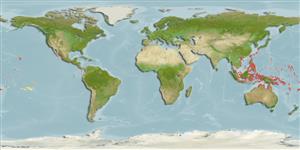Environment: milieu / climate zone / depth range / distribution range
Ökologie
seewasser riff-verbunden; standorttreu; tiefenbereich 0 - 3 m (Ref. 30874). Tropical; 30°N - 18°S
Western Pacific: southern Japan south to northern Queensland, Australia. Has been collected close to the islands in Micronesia, Melanesia, Fiji and New Guinea.
Size / Gewicht / Alter
Maturity: Lm ? range ? - ? cm
Max length : 6.4 cm TL Männchen/unbestimmt; (Ref. 117049)
Rückenflossenstacheln (insgesamt): 4 - 6; Rückenflossenweichstrahlen (insgesamt): 8-13; Afterflossenstacheln 1; Afterflossenweichstrahlen: 13 - 15. Mouth barely protractile and with thin lips. Basihyal and mesopterygoids usually with teeth. No notch present at the anterior border of preopercular bone. Face with Shangreen denticles. Ascending process of premaxilla with no lateral processes present. Distal end of maxilla blunt and truncate.
Loose aggregations inhabit tide pools and rocky shorelines and reef margins. Eggs are large.
Life cycle and mating behavior
Geschlechtsreife | Fortpflanzung | Ablaichen | Eier | Fecundity | Larven
Myers, R.F., 1991. Micronesian reef fishes. Second Ed. Coral Graphics, Barrigada, Guam. 298 p. (Ref. 1602)
IUCN Rote Liste Status (Ref. 130435)
Bedrohung für Menschen
Harmless
Nutzung durch Menschen
Fischereien: nicht kommerziell; Köder: occasionally
Mehr Information
NamenSynonymeMetabolismusRäuberÖkotoxikologieFortpflanzungGeschlechtsreifeAblaichenSpawning aggregationFecundityEierEientwicklung
ReferenzenAquakulturAquakultur ProfilZuchtlinienGenetikElectrophoresesVererbbarkeitKrankheitenVerarbeitungNutrientsMass conversion
PartnerBilderStamps, Coins Misc.LauteCiguateraGeschwindigkeitSchwimmstilKiemenoberflächeOtolithsGehirngrößeSehfähigkeit
Tools
Zusatzinformationen
Download XML
Internet Quellen
Estimates based on models
Preferred temperature (Ref.
123201): 26.2 - 29.3, mean 28.7 °C (based on 1520 cells).
Phylogenetic diversity index (Ref.
82804): PD
50 = 0.6250 [Uniqueness, from 0.5 = low to 2.0 = high].
Bayesian length-weight: a=0.00389 (0.00180 - 0.00842), b=3.12 (2.94 - 3.30), in cm total length, based on all LWR estimates for this body shape (Ref.
93245).
Trophic level (Ref.
69278): 3.4 ±0.45 se; based on food items.
Fishing Vulnerability (Ref.
59153): Low vulnerability (10 of 100).
Nutrients (Ref.
124155): Calcium = 186 [94, 402] mg/100g; Iron = 0.987 [0.515, 1.791] mg/100g; Protein = 19.2 [16.9, 21.6] %; Omega3 = 0.124 [0.050, 0.339] g/100g; Selenium = 13.5 [6.0, 37.3] μg/100g; VitaminA = 331 [96, 1,081] μg/100g; Zinc = 2.16 [1.34, 3.37] mg/100g (wet weight);
